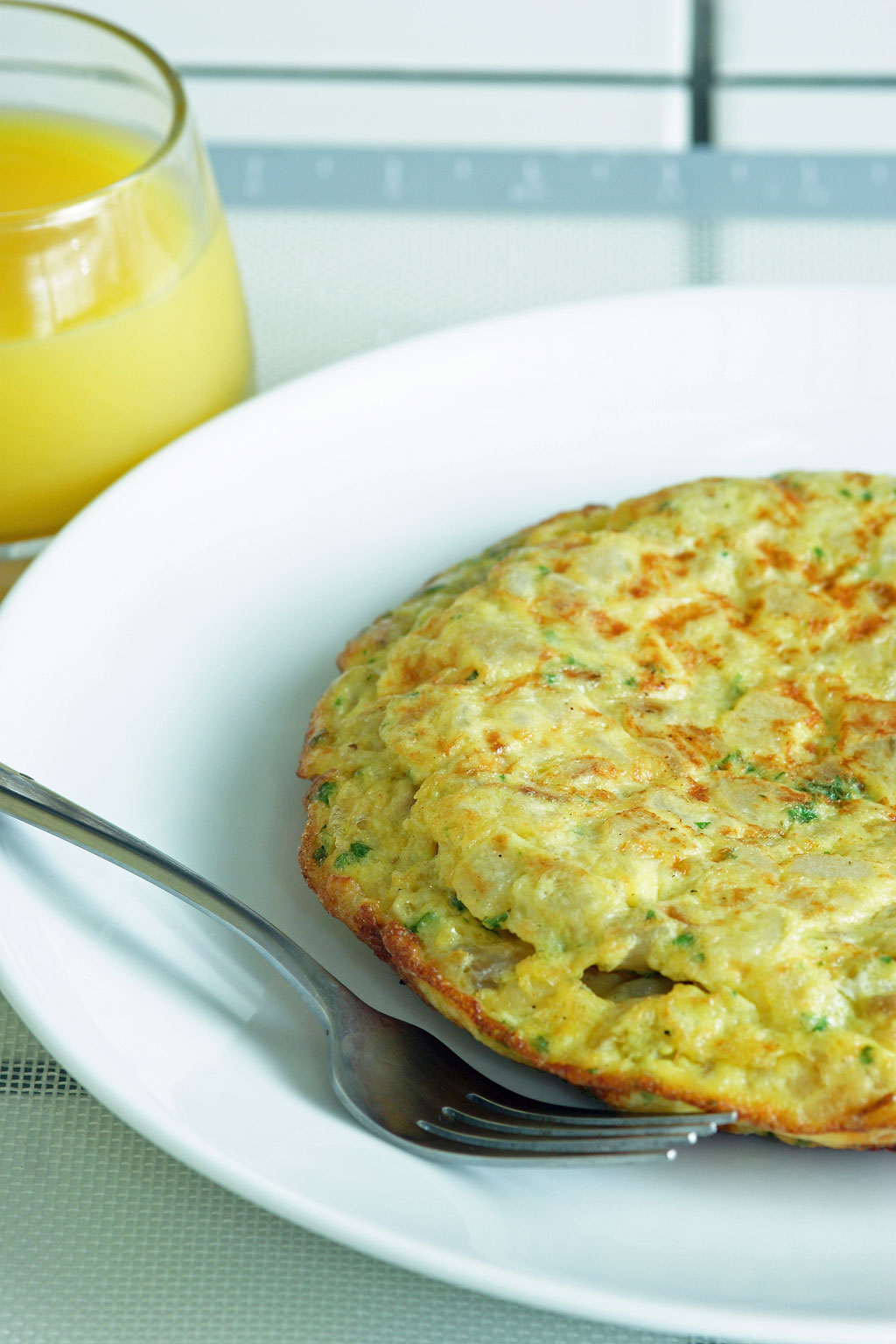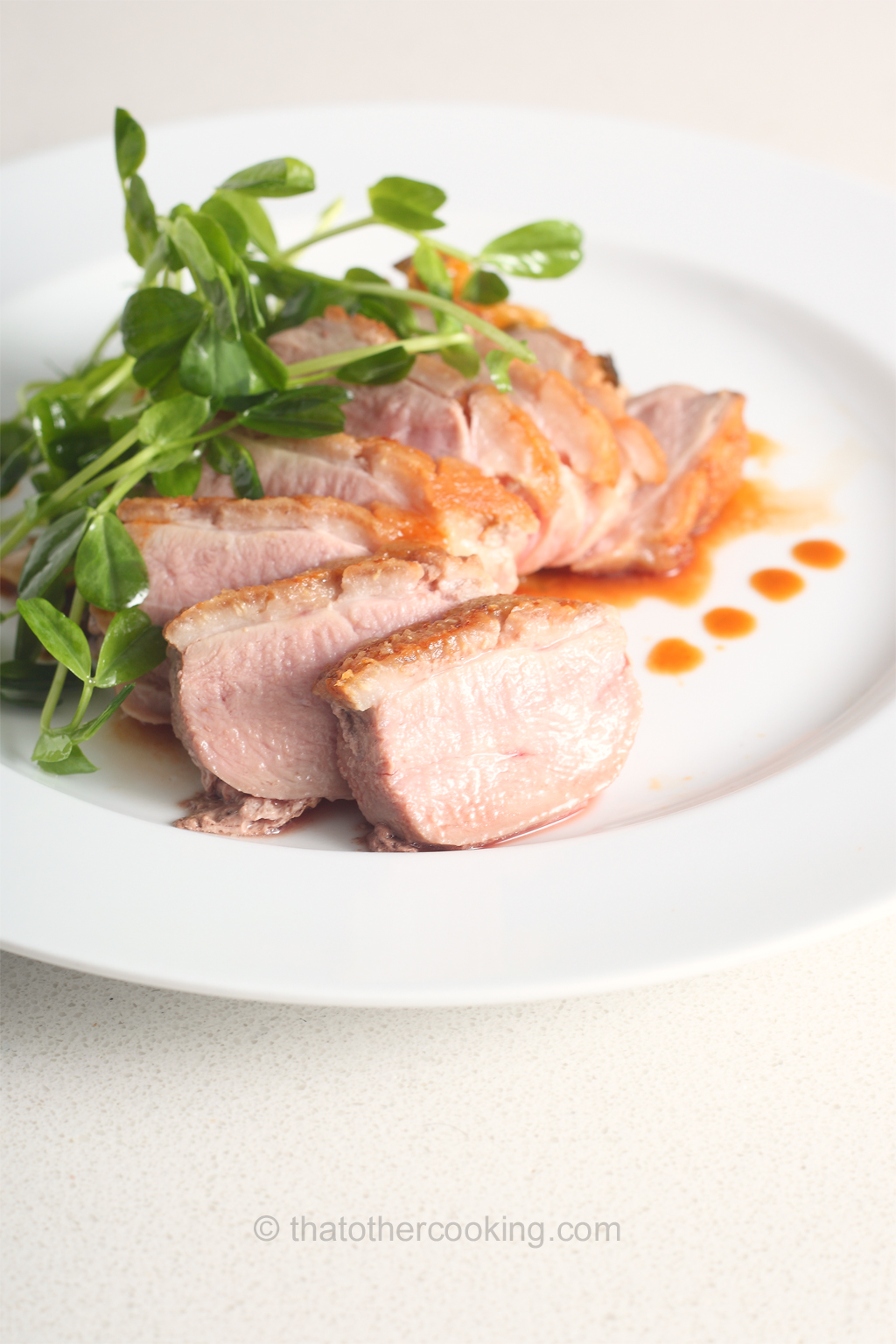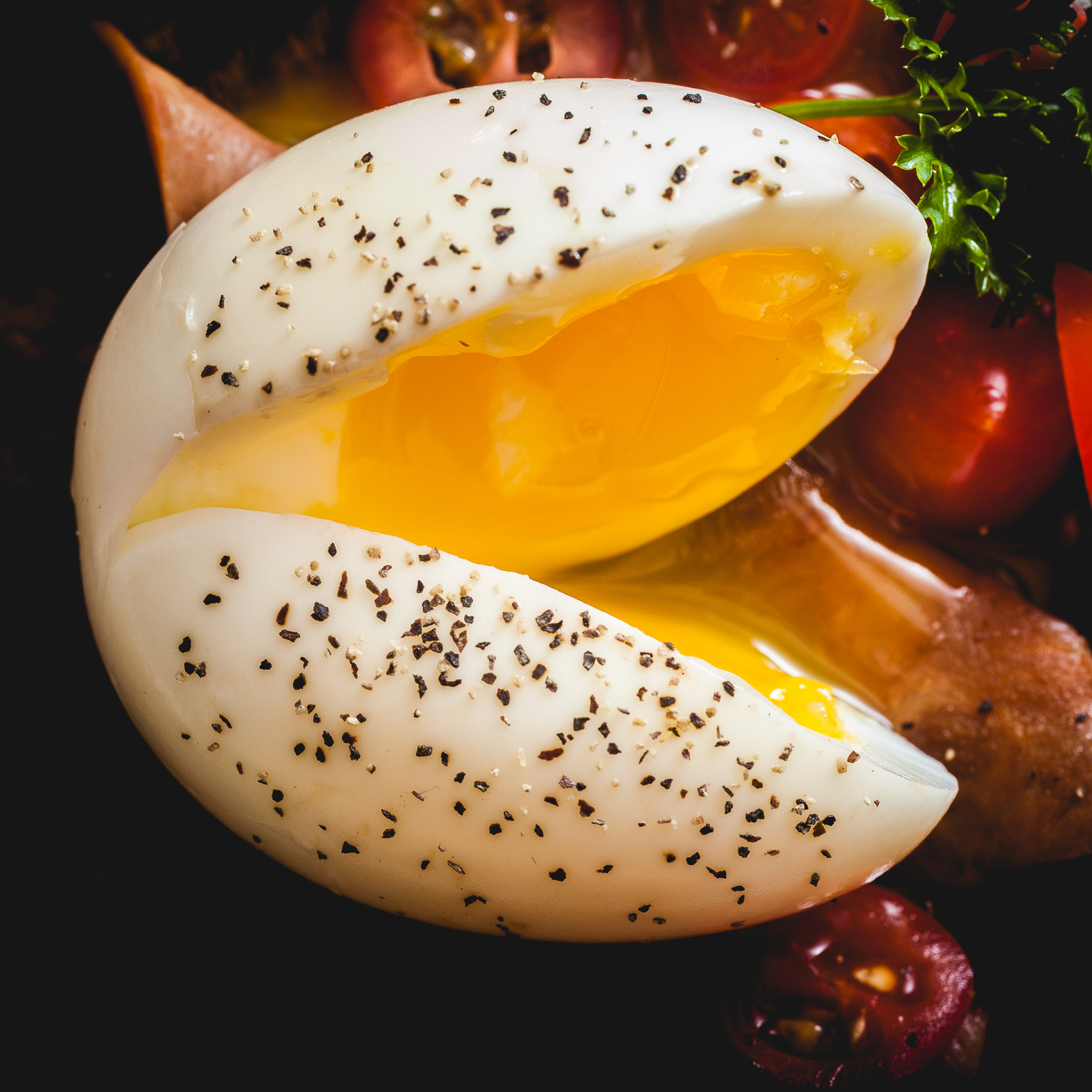I have been meaning to write a better post about this dish which I grew up eating. It’s a classic tapas food in any spanish restaurant or cafe. I have added fennel and some parsley to the mix just to spice things up a bit, it works really well with the onions and the potatoes, but you could omit them and keep the recipe pure and traditional. If you decide to skip the fennel, use twice the onions so your final egg mixture is still well balanced. Also, like in any egg dish, gentle heat and patience will yield the best results. Here’s what you do:

Gear:
medium skillet (I used my cast iron one)
non-stick small or medium pan
knife and chopping board
bowls for prepping ingredients

Ingredients:
1 large russet potato
1/2 large onion
1/2 fennel bulb (equal parts onion and fennel basically)
4 eggs
2 tbsp finely chopped parsley (chop right before using)
kosher salt to taste
olive oil or vegetable oil

Preparation:
01: beat eggs in a bowl, let rest to room temperature
02: chop potato, onion, fennel, medium dice, place in bowl, mix up
03: heat up a skillet to low medium, add oil to coat the bottom
04: sweat vegetables until softened. Stirring is essential. about 15 minutes
05: while doing this, add pinches of salt and taste for doneness and flavor
06: when the potatoes are soft, remove from the heat
07: at this point the fennel and onion should be cooked
08: some caramelization is a good thing
09: mix vegetables with eggs in the bowl, add parsley
10: mix well using a fork or spatula, adjust salt again
11: non stick pan on low heat, add egg mixture
12: let cook undisturbed for about 7-8 minutes
13: with a spatula, check that eggs arent browning too much at the bottom
14: stick your finger in the middle of the omellete and check doneness
15: your finger shouldn’t be able to go deeper than a third of the thickness
16: at this point is time to flip the tortilla, I used the cutting board *
17: place cutting board over pan, place your had over the board, and flip
18: the tortilla should rest on the cutting board, slide it back into the pan, slowly
19: this can be a bit messy if the tortilla wasn’t cooked enough, practice makes perfect
20: cook for another 2 minutes or so, remove from heat
21: slice tortilla out of the pan onto a plate, let rest for 5 minutes


* The tricky part to making this omelette is the flipping of it, because we want it thick the surface of it wont cook until it’s flipped, and since we’re using the entire area of the pan, there is room for maneuvering… I know, this is the traditional recipe, and I wanted this post to stick to the traditions, so no water baths or other tricks here today. I grab my cutting board which isn’t big, just big enough to cover the diameter of the pan, you could use a flat plate or something similar, they even sell special pans with 2 bottoms this this one. Anyways, with confidence, press the board against the pan, and quickly flip the pair so that the pan ends on top of the board, some liquid might spill, you should probably do this over the sink. The tortilla will be on the board at this point, slide it back into the pan slowly, and place the pan back on the stove and finish cooking… will probably take a few trials before you’re comfortable doing this.

enjoy!!!
Wanna get more sous-vide cooking guides and cool cooking how-to’s in your mailbox? You know what needs to be done!
We never spam. You should only be getting updates when new content is posted on the site. We also respect your privacy. We don’t share your email address with anyone and you can unsubscribe anytime!


![Another one of those recipes that almost got left behind. I took the photos weeks ago and I even uploaded them to my site but never got around to write about it which is weird.. guess was distracted by trying not to destroy my blog while making changes to it. It's happened. I love pork chops but they can go wrong pretty easily. They overcook really quick. And you know what that's like.. yeah... rubber soles. Totally unattractive. If you have the time and the equipment go sous vide. No doubt about that. If you don't then sear them in a really hot pan a couple of minutes per side. Obviously we're dealing with pork and we need to make sure it is safe to eat. Trichinosis is a concern and pork should be cooked throughly. Cooking meat throughly doesn't mean overcooking it though. The parasite in question actually dies at fairly low temperatures which is great news. This excerpt from a USDA document is interesting: Cooking - Commercial preparation of pork products by cooking requires that meat be heated to internal temperatures which have been shown to inactivate trichinae. For example, Trichinella spiralis is killed in 47 minutes at 52° C (125.6° F), in 6 minutes at 55° C (131° F), and in < 1 minute at 60° C (140° F). It should be noted that these times and temperatures apply only when the product reaches and maintains temperatures evenly distributed throughout the meat. Alternative methods of heating, particularly the use of microwaves, have been shown to give different results, with parasites not completely inactivated when product was heated to reach a prescribed end-point temperature. The U.S. Code of Federal Regulations for processed pork products reflects experimental data, and requires pork to be cooked for 2 hours at 52.2° C (126° F), for 15 minutes at 55.6° C (132° F), and for 1 minute at 60° C (140° F). But how can one translate this into a recipe? If you're cooking the meat sous vide... it's a no brainer. Set the water bath to 125.6F and cook the meat until the core has spent 47 minutes at this temperature for example. Of course. bare in mind that depending on the thickness of the chop, the total cooking time will need to be calculated. It's usually a few hours for individual chops just like the paragraph above suggests. Now, if you're cooking the chops in a skillet... things get a bit trickier and experience plays a big role in getting the meat cooked through but not overcooked. The thicker the chop, the trickier it gets. The leaner the chop, the quicker it cooks... all these catches. I personally observe a few things while pan searing pork chops at home: Thickness... I stay at about a inch or less other wise, sous vide, grill or roast. I bring the meat to room temperature. I salt the meat way ahead of time. If I have time I brine the chops instead I use a thermometer. I sear the chops in a really hot skillet a couple of minutes per side. I check internal temperature at various points. I finish in the oven if needed otherwise... I cover the pan with a lid and remove from the heat until cooked through. This might take several minutes so I check with a thermometer periodically. Sounds like a pain in the ass and it is but some repetition helps. Done a few times it becomes second nature. To my advantage it's really hard not to kill this parasite. If I work above 130F for the internal temperature it's pretty safe and the chop should be pretty juicy still. Anyways, don't take my word for it. I'm not an expert in the field that's the sort of thing I keep in mind when I'm cooking pork. Same with game meats. So moving on! Here is the recipe: [yumprint-recipe id='9'] enjoy!](https://thatothercookingblog.com/wp-content/uploads/2016/03/img_6621-1200x1200.jpg)


20 comments
Very nice post, Paul! I like your idea of adding fennel, as I find the traditional tortilla al patatas (as I know it) a bit bland. Having two left hands, as we say in my country, the flipping is always very tricky for me. Great that you point out that it will take some tries to do this confidently — that will help prevent anyone trying this feeling very stupid 😉
thanks Stefan! And you are correct, the name is tortilla de patatas, known in some spanish speaking places outside spain as tortilla espagnola, the original recipe didn’t even feature onions, that was a later addition. Fennel, parsley, I’ve added spanish chorizo as well, like anything else, building on top of the basics is usually fun and rewarding. The flipping though… oh my god, the number of disasters I should have photographed 🙂
I wasn’t sure about the onions, as the last time I’ve had one in Spain was 25+ years ago. I’ve had too many tortillas de patatas and omelettes aux jambon on vacation as a child, before my parents figured out that I like to eat pretty much everything 🙂 And so afterwards I’ve stayed away from them. (We usually went to Spain or France.)
I’ve only been to spain a few times, but my mom and grandma made these all the time, always with onions, which is great, because I do love onions 🙂 Once I tried red onions, it was a complete disaster, they turn to a grayish green hue, totally unappetizing, they taste ok… not great, so yellow or white onions is what I always use.
PS Great photos!
Im glad you like them, thanks Stefan! My setup is pretty simple, gitzo tripod, sigma macro 70mm, flash unit (i got a pretty cheap one), Im using my old camera body, a canon 20d, My kitchen is super dark which I hate, nothing like sunlight for food photography.
Besides the equipment, the person that operates it is also important 🙂 You just listed two things I don’t have, which are a tripod and a fixed lense. I’m using a point-and-shoot camera, albeit a high-end model.
appreciate that 🙂 Also, when I started my blog I used my cell phone camera… and eventually figured I’d be blogging for a while so I ended up combining 2 of my hobbies into one, that’s when I started using my SLR and the tripod and all that… is lots of fun. I use a 50mm sometimes, and I’ve also taken some shots with an 80mm, all prime lenses, although a zoom would do just fine. A tripod is probably the most important thing, unless you’re doing pure flash photography, with no available light like in my cave-like kitchen haha
I’m thinking a tripod would be in the way while I’m cooking. I’m still trying to do cook as naturally as possible, and taking photos without ‘interfering’, but that’s getting harder and harder as I’m becoming more critical of the photos…
I hear yah, it can be a pain in the ass, and you have to time things factoring in the photography component, but I enjoy both so I’m willing to suffer a bit 🙂 some people setup their camera so it is out of the way and with a trigger release they can shoot away from the camera, I’ve done that as well. Maybe a good compromise would be to document the process with the point and shoot handheld, and then only take some extra time to take a better picture of the final dish
Taking photos interfering with the cooking process is one thing, but I certainly wouldn’t want the final result to suffer 😉 That and by the time it’s time to shoot the finished dish there is usually a hungry husband waiting before he can ‘dig in’ 😉
its all about compromises and sacrifice 😉 just kidding… but not really haha!
Sometimes I plate a dish after dinner so nobody gets hurt AND leftovers deserve the right to be treated with as much respect and vanity haha and that’s the photo that goes on the blog, sometimes the time food requires to rest before eating is the perfect opportunity to take the shot. Sometimes you can tell the level of hunger by the quality of some of my pics, inversely proportional hahahah 🙂
That is a pretty good law of food blogging photos 🙂
I almost never have leftovers.
hahaha fair enough!
I LOVE tortilla espanola. Why is it called that though? Give me a history lesson!
Hey Raechel, I don’t think I can school anyone on food history, but here is a great wiki entry about this dish, and like Stefan said, this dish is also known as Tortilla de Patatas. Thanks for checking in! it’s been a while! 😉
http://en.wikipedia.org/wiki/Spanish_omelette
forgot to paste the link!
Another great recipe and post, Paul. When I shared my frittata post, a number of people mentioned Spanish tortillas and I’m glad now to see a recipe. I like your idea of adding fennel. I bet that gives the dish a great taste.
thanks John! Im so glad you like this post, I was probably the one of the ones making the spanish omelet comment 😉 Adding fennel did one thing I never thought, it brightened up the dish, didn’t add the anise like layer, I guess because of the long cooking time to soften it along with everything else, but its flavor helped the others come up a bit which was great!